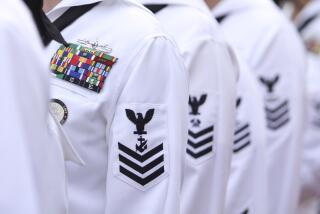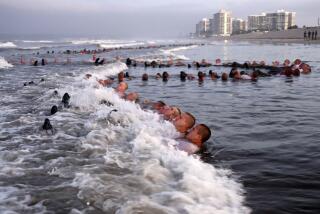Sailors With AIDS Virus Play a Role in Research : Medicine: Navy’s early detection of infected patients helps doctors at the Navy Hospital in Balboa Park study new treatments.
- Share via
At the huge Navy Hospital in Balboa Park, the Navy is treating its largestcontingent of sailors infected with the AIDS virus.
Unlike the civilian world, where those with the disease or its virus may not be detected for years, the Navy is able to identify relatively early those infected because of the military’s mandatory testing requirement.
What this also does is provide Navy doctors with an unusual window for research.
“We probably have the greatest potential to contribute because of our unique patient group,” said Dr. Charles Kennedy, acting director of the Navy Hospital’s Human Immunodeficiency Virus Unit.
“The population in the military is really the population you want to study. . . . In the civilian world, by the time patients come in and are tested, they are incredibly wasted. You don’t have a lot of time to intervene--you’ve lost the window.”
Many of the sailors voice similar feelings. They believe they are part of the quest for an AIDS cure.
“I am in it for myself and for the future,” said Keith, a 30-year-old electrician and participant in one major vaccine trial. “Even if I die of AIDS, I hope this will help someone else.”
At the hospital, about 80% of the 900 infected sailors and retired Navy personnel are participating in research projects, ranging from trying out a new Salk vaccine to monitoring medications, from gauging heterosexual transmission to measuring sleep disorders. But because of limited funds and a staff depleted by the Persian Gulf War, researchers have not been able to take full advantage of the opportunity afforded by their patient group, Kennedy said.
During normal peacetime operations, the HIV unit is manned by three doctors. But last August, the director and another doctor shipped out to the Gulf--leaving Kennedy in charge of the unit, which has about 600 patient visits monthly.
“Obviously, I am stretched exceedingly thin,” Kennedy said.
As a result, some research cannot be done. While the HIV unit sees its patients earlier on in their infection than the civilian counterpart facility would, doctors cannot say whether earlier detection and treatment has meant their patients are living longer.
But some Navy experts believe that, with early detection, the Navy cannot just prolong lives but also can improve the quality of those lives--a theory not yet supported by research.
“We’re improving the longevity and the quality of life by testing early. We are following patients and giving high-quality care, and we may be prolonging people’s lives over what the civilian sector is doing,” said Dr. Kenneth Wagner, director of the Henry M. Jackson Foundation for HIV Research at the National Naval Medical Center at Bethesda, Md.
The key, said Wagner, is early detection.
Since 1986, more than 2 million military personnel have been tested for acquired immune deficiency syndrome. About 7,800 have tested positive. Of those, 1,745 are still on active duty and the others are no longer in the military, according to the Pentagon. Navy officials say there are currently 850 active-duty sailors who have tested positive.
Sailors and soldiers who test positive can remain on active duty for as long as they are healthy, or until their blood T-cell count drops below 400. At that point, they are usually medically discharged and provided with standard military benefits, including free medical care.
For the Pentagon, the AIDS crisis may mean an expensive outlay. By the year 2,000, the military could face $3 billion in AIDS-related health care costs, according to a General Accounting Office report released last year.
At Navy facilities, doctors are battling the disease on several fronts: to prevent infection, develop a vaccine, and slow the progression of the disease, Wagner said. And some military researchers are also looking at ways to cut costs.
In San Diego, 144 patients participated in a study that ultimately saved the hospital $100,000, Kennedy said. Many patients infected with the HIV virus are treated with a medication, aerosolized Pentamidine, which helps prevent the outbreak of a pneumonia that strikes patients whose immune systems are weakened.
At $103 a month, however, the medication is costly.
In the study, infected individuals were given an oral antibiotic, Septra, that costs about $1.80 a month, Kennedy said. About 70% of the patients were able to handle the cheaper medication with the same benefits as the more expensive one, he said. The others, however, were taken off the cheaper drug because they could not tolerate it, developing fevers or rashes, he said.
The discovery changed the way patients at the HIV Unit are treated. Instead of automatically being given Pentamidine, they are now given Septra, said Kennedy, who will present the results of this study at the annual international AIDS conference in Italy next month.
“The cost savings was pronounced,” Kennedy said.
AIDS, for which there is no known cure, is a viral disorder that attacks the body’s immune system, leaving a person vulnerable to opportunistic infections and cancers. It is contracted primarily through sexual contact, the sharing of contaminated intravenous needles by drug users, or blood transfusions. And the disease is widespread in the gay community but in recent years has spread increasingly to nongays.
At the Navy Hospital, because sailors are subjected to random drug tests, doctors find few of their patients contracted the virus from using drugs.
But since homosexuality is grounds for discharge, virtually no male patients say they were infected from a gay encounter. So while some civilian researchers are studying various aspects of transmission and behavior in the gay community, military research does not tap this area.
At the Navy Hospital, research projects include:
* How the virus is transmitted between heterosexual couples through sperm during sexual intercourse.
* Sleep disorders among infected individuals.
* The effect of the virus on the nervous system.
One of the more high-profile research projects at the Navy Hospital is the study of a vaccine developed by Dr. Jonas Salk, who created the polio vaccine. So far, 14 infected patients have enrolled in the study and at least another six are expected to join, said Elaine Schreiber, a clinical research coordinator.
The Navy Hospital is one of nine study centers to participate in the double-blind experiment, where half the participants will receive the vaccine and the others get a placebo. The Navy Hospital is the only military facility involved in the test of the Immunogen vaccine, made from a dead virus. Navy patients, who began enrolling in October, are monitored monthly to see if the vaccine halts the progression of the virus.
Salk hopes that his vaccine will prevent infected patients from developing AIDS as well as prevent uninfected individuals from getting the disease. The results from the study will be analyzed next year.
The vaccine study, as well as other studies under way, allow patients to feel more optimistic and active about the search for a cure.
Although Salk’s vaccine is currently the only one being studied at the Navy Hospital, doctors hope to begin studying another, GP-160. This vaccine, composed of protein from the surface of the virus, will be studied at other military facilities as well, Wagner said.
Wagner and other Navy doctors said they believe their efforts will pay off.
“We are all more hopeful, the problem is still much further away from a solution than we would like it to be,” Wagner said, “but with every day, there’s something on the horizon.”
Some patients at the hospital are also optimistic. Said Petty Officer 3rd Class Ronald Twa, “I know I’m going to live through this. I’m going to die of old age.”






